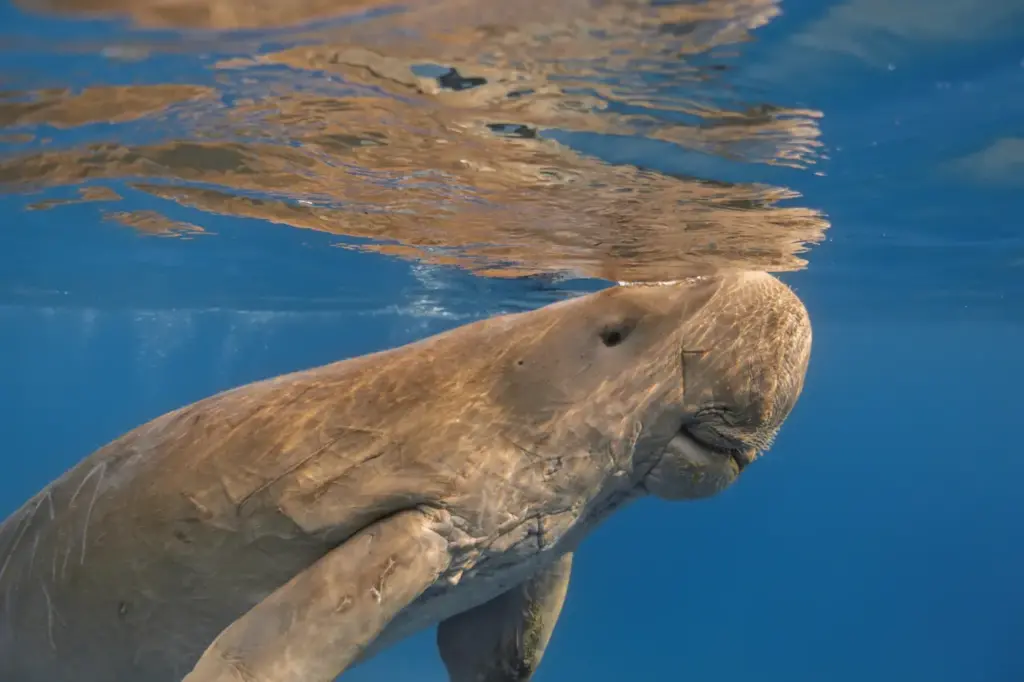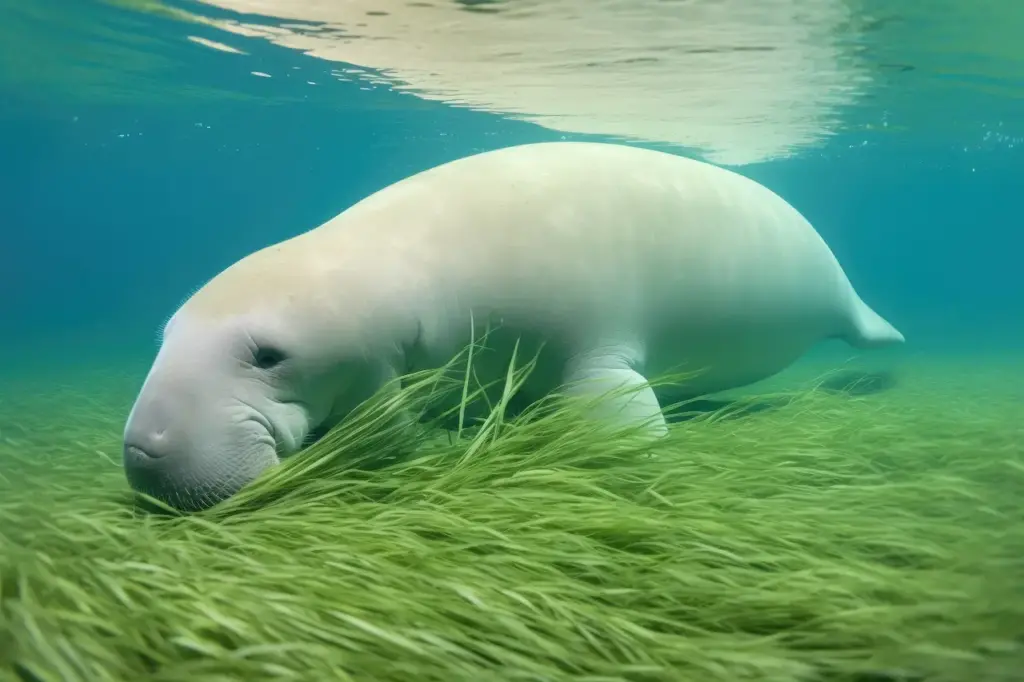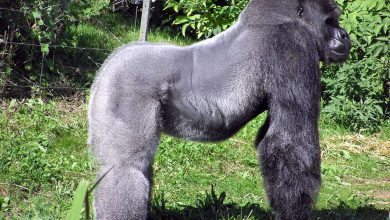What Eats A Dugong? What Does Dugong Eat?
Introduction
Large, grey creatures called dugongs live their whole lives in the water. When fully developed, they might have a length of three meters and a weight of 400 kg. Dugongs use their two flippers in addition to their huge, whale-like tail to propel themselves forward. They emerge to breathe from the tops of their snouts, which are their nostrils. The bristles around the mouth are the only hairs on dugongs.
Similar to all other sea cows, dugongs are herbivorous. It spends much of its time in seagrass beds since it mostly grazes on seagrasses. As the only completely marine mammal that is herbivorous, the dugong never enters freshwater, in contrast to the closely related manatees. The dugong has a fairly small brain about its body size, probably because it does not need to devise intricate hunting techniques to obtain prey.
Dugongs are not typically preyed upon by many animals. There are a few predators that may target them under certain circumstances:

1. Sharks
Sharks usually use ambush techniques to target dugongs, taking advantage of their fragility in shallow coastal waters during feeding or resting times. Due to their slow movement, dugongs are easily preyed upon by opportunistic predators such as sharks. Sharks typically initiate attacks by rapidly closing in on the unwary dugong and using their excellent sense of smell to identify possible victims. When the shark is close enough to attack, it uses its strong jaws and razor-sharp teeth to sever the dugong’s body, frequently focusing on important parts like the abdomen or flippers.
Even with its thick skin and powerful body, the dugong’s defence mechanisms against the swiftness are frequently ineffective. The quickness and intensity of its attacker often render the dugong’s defenceless attempts ineffective. Once the dugong is rendered unconscious, the shark will consume its flesh by slicing off pieces of meat with its serrated teeth. In addition to endangering individual dugongs, these attacks add to the larger conservation issues regarding this endangered species since predation pressure can further reduce already declining populations.
2. Crocodiles
Dugongs are attacked by crocodiles when they travel into the coastal regions that are home to these aquatic mammals. Dugongs may not attack crocodiles directly, but their presence may draw them closer. Being opportunistic hunters, crocodiles might view dugongs as a possible meal, particularly if they are hurt, feeble, or exposed. With their powerful jaws, crocodiles can quickly launch themselves from the water or from hidden spots on land to grab unwary dugongs. Dugongs are at higher risk due to the power of crocodiles’ bite and their capacity to pull the prey into the water to eat.
3. Killer Whales
Large herbivorous marine mammals found in shallow coastal waters of the Indian and Pacific Oceans, dugongs, have been reported to be attacked by killer whales even though their primary food is marine mammals.
Because dugongs mostly eat seagrass, killer whales do not typically hunt on them. On the other hand, there have been reports of killer whales attacking dugongs, especially in areas where their habitats overlap. These attacks are uncommon and might happen in certain situations, including when killer whales are especially ravenous, inquisitive, or maybe acting opportunistically when hunting.

4. Tiger Sharks
The dugongs are usually attacked by the sharks when they come across them when they are out foraging. Dugongs, sometimes called “sea cows,” are vulnerable prey for tiger sharks since they are herbivores and don’t present much of a threat. Due to their excellent sense of smell, tiger sharks may be able to identify a weak or injured dugong because they are drawn to the smell of disturbed or injured prey. When a tiger shark attacks a dugong, it usually uses its powerful jaws and sharp teeth to cause deadly wounds.
The goal of the ambush-style attack is to immobilize the dugong and prevent it from escaping by using quick and forceful hits. Tiger sharks may inflict severe injuries, including severe trauma and often the death of the dugong, with their powerful biting force and keen teeth.
Tiger sharks usually eat a lot of the dugong’s flesh once they have rendered their prey unconscious, then continue to feast on the carcass until they are satisfied. Tiger sharks are essential in controlling the number of prey in marine habitats.
Therefore, these assaults support the natural processes of predation. The delicate balance between predator and prey in coastal locations may be impacted by human activities that disturb these ecological relationships, such as overfishing and habitat loss.
5. Dolphins
Dolphins, such as bottlenose dolphins, are known to cooperate to corner and ambush their prey. They pursue dugongs with their faster swimming speeds, guiding them into areas with less space for escape.
Dolphins use different techniques to hunt dugongs, such as biting, ramming with their snouts, or pushing the animal with their heavy weight to prevent it from coming to the surface to breathe.
Dolphins cooperate when hunting dugongs, circling and guiding their victim into shallower waters where it becomes more difficult for them to flee. Their timing and synchronization are perfect as they strike the dugong with their snouts or flippers, debilitating it. After their target is rendered incapable, the dolphins can go ahead and devour it.

6. Large predatory birds
Predatory birds do not hunt dugongs directly. These birds attack when the dugong goes into shallower waters or when it is already vulnerable because of a disease or injury. In this situation, the bird would dive down and try to snatch the dugong with its talons, aiming for delicate tissues or exposed flippers as potential targets.
Even though these events are rare, they show how intricately linked marine ecosystems are, as well as how predators can adapt to take advantage of atypical possibilities for food.
Conclusion
Dugongs face threats from habitat loss, climate change, and human activities such as fishing, boat strikes, and entanglement in fishing gear. Dugongs face predation from natural predators such as sharks and killer whales, which is typically not a significant factor in their population decline as compared to human-induced threats.
Scientists think the dugong is vulnerable to extinction because populations are declining in some areas and going extinct in others. The dugong may disappear from more areas if human activities that endanger it are not carefully managed.




